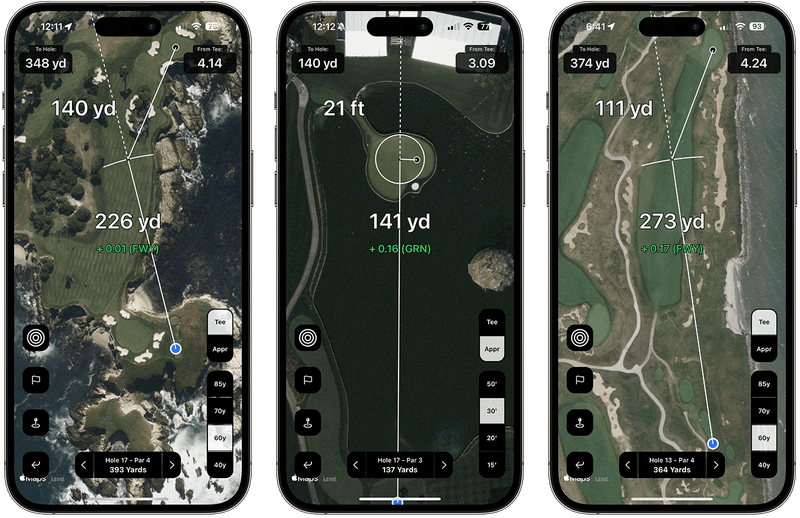Four months after launching my app, someone offered to buy it: Here’s why I didn’t sell
Indie developer Eric Duffett takes us through the story of negotiating a deal on Shot Pattern (and what gave him the confidence to say no)

Like many indie developers, I launched my app, Shot Pattern (a golf strategy GPS app), as a passion project that solved a problem for me personally.
I published the app with high hopes, but very modest expectations. As many indies are inclined to do, I was focused on building the features that were interesting to me and never put a great deal of my attention on the business metrics. Yet, just four months after launch, I found myself in a dream scenario: a group reached out with serious interest in buying the app. As a result, I was thrust out of my comfort zone of treating my app like a hobby, and now needed to quickly figure out how to value it as a true business.
I’ve seen a few posts from other indies who have found themselves in a similar situation and I wanted to share my experience in trying to tackle this issue in hopes that it’s valuable to others. If you’re an indie who enjoys development, but feels a bit miffed by the business side of building an app, I hope this blog post helps you get more comfortable understanding your app as a business.
Acquiring customers (and, accidentally, an interested buyer)
One of the first business challenges of any app is profitably acquiring customers. Since I wasn’t ready to pour money into paid marketing, I decided to take a more organic approach. Delving deep into marketing strategies isn’t the focus here, but it’s worth mentioning since it’s also how my suitors discovered me.
Without a budget for paid advertising, I leveraged social media, particularly X, to engage with my target audience. There are a few thought leaders in golf strategy & stats who have large followings on X. I’d created a new account for my app and didn’t have my own audience, so I took the approach of engaging in their conversations, posting meaningful replies, and adding value to the community. Whenever it added to the conversation, I’d use app screenshots as part of my post. At this point in my account’s history, traditional posts from my account out into the void would manage just a few hundred impressions, but a carefully crafted reply to one of these creators could easily net five or ten thousand. At one point, I had a reply with a screenshot of my app get 181K impressions – for free!
With this, my app grabbed the attention of several “high profile” people around the golf industry and eventually became the lead for my acquisition offer.
Slowly, but surely, I started to build my own following. Then, finally, I managed to hit on an algorithm-friendly post with a teaser for a feature I was working on that earned 25K impressions on its own. With this, my app grabbed the attention of several “high profile” people around the golf industry and eventually became the lead for my acquisition offer. One of the owners of the business downloaded my app after seeing it on X, used it to prepare for a golf tournament, and went on to win that tournament the next day. I’m not taking any credit for his excellent play, but it certainly made it easy to get his attention. The group he’s a part of operates a tangentially related golf business, and was considering adding a feature-set like mine to their lineup of products.
Content marketing is a long, slow, difficult game in and of itself, but the reward of doing it well is a near zero cost of acquiring customers. It’s definitely going to be a focus of mine going forward and it’s something I’d recommend to any indie developer who is looking to grow their app in a way other than giving all of their money to Meta or TikTok.
RevenueCat Charts: Clarity in the fog
As we started discussions, the promise of a guaranteed payday was really appealing, but I was also filled with fear that I was going to walk away from a massive opportunity because I didn’t understand my own business.
In trying to put a number on my app, I quickly realized that my app was simply too new to value based on traditional valuation methodologies where current earnings are used as the basis for discussions. Given that it had only been a few months, I needed to find another approach to figuring out the price at which it was worth it for me to walk away. The question I needed to answer to determine if I wanted to sell was “What’s possible for this app two to three years from now if I choose not to sell?” I wanted to do my best to view my app through an objective lens and try to pull away from my emotional ties to what I’d built.
As someone initially driven by passion rather than profit, I had little initial grasp of the importance of metrics like Trial Start Rate, Trial Conversion, or LTV. However, when my acquirers asked me to share relevant app metrics, I started to dig more deeply into my app’s performance. During this deep dive, I discovered RevenueCat’s “State of Subscription Apps” report. The benchmarks in the report offer tremendous insights into industry norms for the most important metrics in a consumer subscription app.
Comparing my metrics to the RevenueCat State of Subscription Apps Report, I discovered:
- My Trial Start Rate: 25% (RevenueCat upper quartile benchmark of 8.7%)
- My Trial Conversion Rate: 74% (RevenueCat upper quartile benchmark of 58%)
- My Conversion to Paying: 16.3% (RevenueCat upper quartile benchmark of 4.4%)

Once I understood my RevenueCat metrics in the context of this report, I had a much different view of my app. These numbers, significantly above industry benchmarks, provided a clear signal: my app was resonating with its audience. Given how well the app was performing, I took it as a signal that not only was there a sign of product-market fit, but I was likely significantly underpricing my work.
I launched a RevenueCat experiment to test doubling my price. Despite a slight dip in initial conversion and conversion to paid, I watched my LTV soar by over 40%. Signs were piling up that I had a legitimate business on my hands, not just a hobby.

Turning down the offer
With all of this data in hand, I had the confidence to go into negotiations with high expectations. Even though I didn’t have high revenues at this point in time, I had strong indicators that I was building something valuable to my target audience. When the other party came to me with a low-ball offer, I knew better than to accept. We tried to come together on a number, but ultimately the price they were willing to pay and the price at which I was willing to sell were too far apart. For me, the positive signs I was getting from my business metrics were a reason to bet on myself and not settle for a quick buyout. My MRR was still low,
So far, it seems to have been the right decision. I’ve learned that professional golfers at the highest levels are using the app along with their coaches, the app was mentioned in a Golf Digest article of “21 products for golf nerds that’ll upgrade your game in 2024,” and I’ve watched my MRR and subscriber numbers continue to grow. If I can get the content marketing right, there’s a chance my revenue in 2024 will surpass their initial lowball offer.
Even though we didn’t reach a deal, I’m grateful for going through the negotiation experience because it taught me a lot. If I had one piece of advice for the other indies out there, I’d tell you to make sure you’re dedicating adequate time to the business aspects of your app. It’s really fun to build the next great feature, but if you want there to be a payoff for your labor of love, set aside at least a few hours every week to look at your app as business. At the beginning, be sure to click past the MRR, and spend time evaluating your trial start rate, trial conversion rate, and LTV as those numbers can be a terrific leading indicator of where you’re headed.
I hope it’s up and to the right!
You might also like
- Blog post
Modeling attribution on iOS: what works, what doesn’t, and how to choose
How to navigate the messy world of SKAN, AEM, and probabilistic attribution — plus two practical frameworks to get a clearer picture of campaign performance.
- Blog post
Your sprints must pay for themselves: Dan Layfield’s product advice
What’s worth building? Dan Layfield shares a 3-bucket framework to help app teams prioritize features, fix churn, and ship faster.
- Blog post
Is monetization hurting your app’s user experience?
Don’t trade short-term revenue for long-term trust. How ethical UX can still drive effective monetization.

